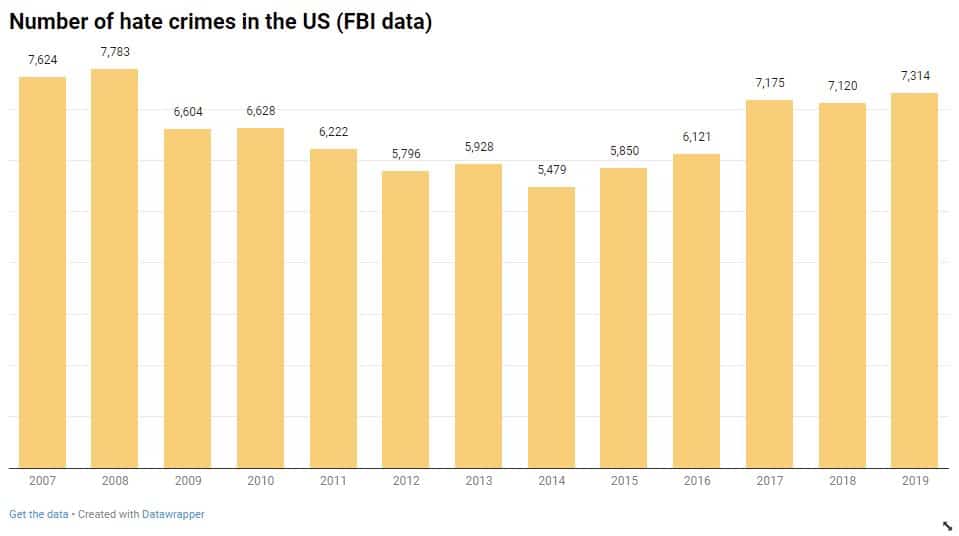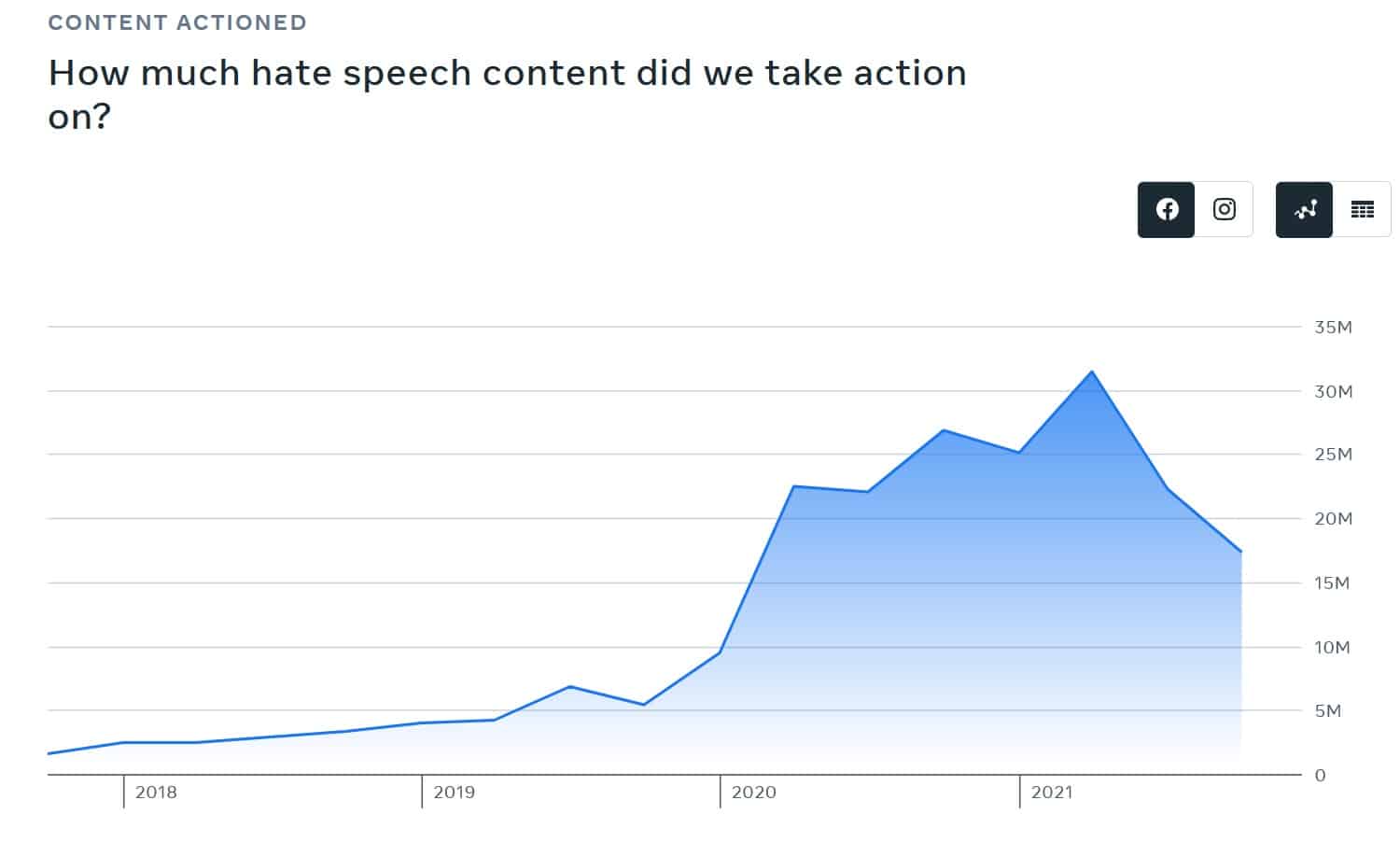Hate crimes, varying slightly in definition across regions, are generally recognized as crimes driven by prejudice against race, religion, sexual orientation, disability, or other attributes. In the US, after a decline between 2008 and 2014, hate crime rates have been rising, but the actual scale is likely much more prominent due to underreporting.
The internet is a significant venue for hate crimes, especially through hate speech, which, while not always illegal, often crosses into criminality when inciting violence or hatred. The intersection of hate speech and hate crimes highlights a debate between hate speech and freedom of speech, complicated by underreporting and lack of transparency from key stakeholders. This overview presents crucial facts and statistics about hate crimes and hate speech.
1. More than half of 2020 US hate crimes were motivated by race, ethnicity, or ancestry
In 2020, the FBI received reports of 8,263 hate crime incidents, up nearly 13 percent on the 7,314 of 2019. The vast majority of hate crimes reported to the FBI are dubbed “single-bias” incidents which are believed to involve one bias. Of those, in 2020, 61.8 percent were motivated by race/ethnicity/ancestry bias. 20.0 percent were motivated by sexual orientation, 13.3 percent by religion, 2.7 percent by gender identity, 1.4 percent by disability, and 0.7 percent by gender.
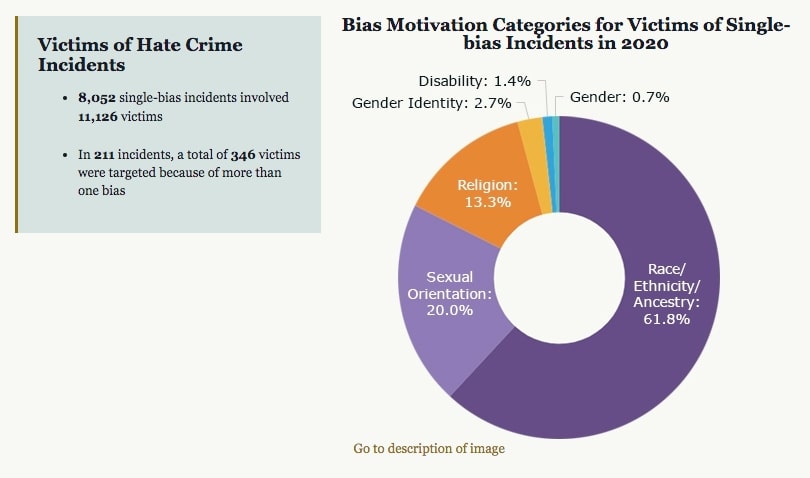
2. Hate crimes in the US have reached their highest level since 2008
While there was a steady decline between 2008 and 2014 (apart from a slight increase in 2013), the number of hate crime incidents recorded by the FBI has increased steadily since then.
3. There could be an estimated 200,000 hate crimes each year
Although the official figure for the number of hate crimes in the US has hovered around 7,000 for a few years, a 2019 Bureau of Justice Statistics survey estimated that the real number could be over 200,000 per year. The low official numbers make sense given that 86 percent of reporting police agencies had no hate crimes on record in 2019. However, there is concern that some reporting processes are failing and police departments are misclassifying some crimes. One apparent reason for this is that hate crimes are notoriously difficult to prosecute.
4. 2% of UK hate crimes were flagged as being committed online
In the UK, 114,958 hate crimes were recorded by police between March 2020 and March 2021, a 9 percent increase on the reported figures from 2019/20. When including figures from Greater Manchester Police, there were 124,091 offences in total. The increasing is put down to better recording methods as well as greater awareness regarding how to report hate crimes.
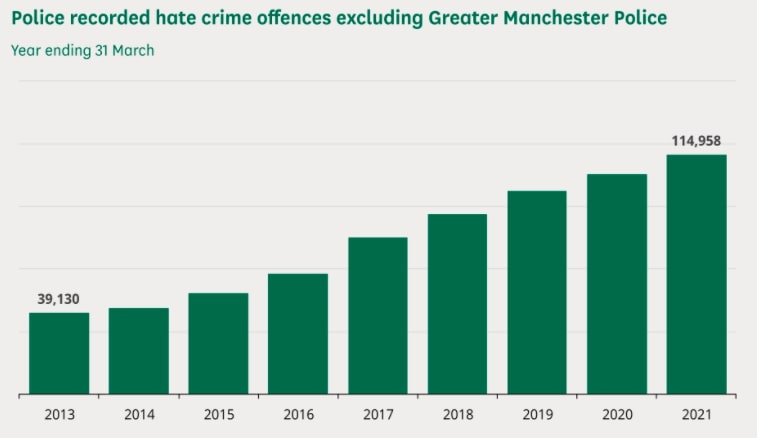
Since April 2015, it was mandatory to flag offenses committed partially or fully online (via a computer, computer-enabled device, or computer network). In 2017/2018, the portion of hate crime that bore an online flag was two percent. However, there is concern that the flag was underused by law personnel, to the extent that similar data was not even analyzed in subsequent years. This means that the real proportion of online hate crimes could have been much higher.
5. 80% of UK online hate crime involves “Violence against the person”
Of the UK hate crimes that were flagged as online offences, four out of five involved “violence against the person.” In comparison, the figure for this type of crime as a percentage of overall hate crime was 33 percent. A significant portion (14 percent) of online crime involved public order, but this was the focus of a much higher percentage (56 percent) of overall hate crime.
6. Most UK online hate crimes involved race
Out of 1,784 reported online hate crimes in 2017/2018, 928 (52 percent) involved race and 352 (20 percent) involved sexual orientation. Disability (13 percent), religion (12 percent), and transgender (4 percent) were other major factors.
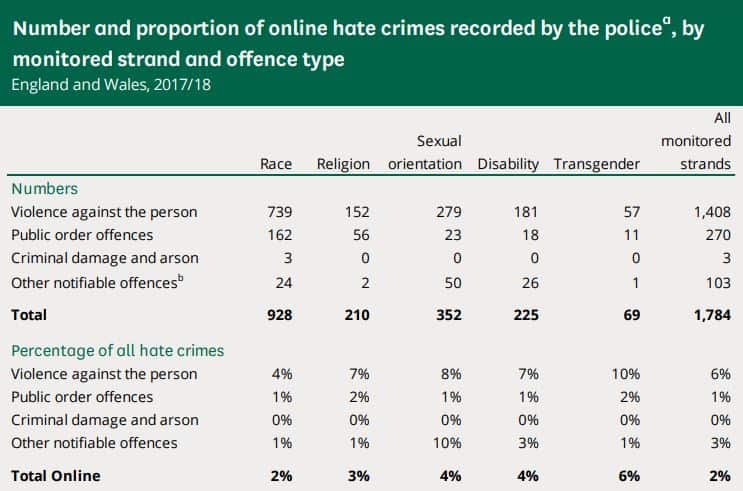
7. In Canada, 60% of hate crimes are racially motivated
Of the 2,669 hate crimes reported to police in Canada in 2020, 1,594 (59.7 percent) of them were motivated by race or ethnicity. Nearly 20 percent were motivated by religion and almost 10 percent by sexual orientation. Other motivations including language, disability, sex, and age.
8. 50% of Canadians have seen online hate
A 2021 Canadian Race Relations Foundation survey (PDF) found that 50% of respondants had either seen or personally experienced online harassment. Notably, younger people were significantly more likely to have noticed hate across every category, especially if they belonged to a racial minority.
9. 64% of LGBT+ people in the UK have experienced violence or abuse
Galop’s Online Hate Crime Report 2021 surveyed over 1,100 LBGT+ people and found that 64% had experienced anti LGBT+ violence or abuse. Nearly a fifth of respondents (16%) had experienced violence or abuse on a daily basis. The most common type of abuse was verbal (92%) followed by online abuse (60%).

10. Fewer than 13% of UK respondents report abuse to police
Galop found that only 13 percent of LGBT+ victims in the UK report their experiences to the police. Furthermore, only 46 percent of respondents who did report to the police were satisfied with the response they received.
11. There is a correlation between online hate speech and physical crimes against minorities
A 2019 study by academics from Cardiff University’s HateLab found that an increase in the prevalence of hate speech on social media platforms can lead to an increase in the number of physical-world crimes against minorities. The study compared London crime data with Twitter data and found that the number of crimes aggravated by race and religion in a location rose when the number of “hate tweets” made from that location increased.
This research backs up a similar study conducted between 2015 and 2017 in Germany which found that negative online rhetoric about refugees may have increased the rate of hate crimes against refugees. One more study by NYU focused on discriminatory tweets related to race, national origin, and ethnicity, and found similar results.
12. Twitter hate speech against China and the Chinese increased 900% in early 2020
A study conducted by AI-technology company L1ght analyzed millions of websites, including social networks, gaming sites, and teen chat forums, to examine increases in cyberbullying, hate speech, and online toxicity. It found that between December 2019 and March 2020, in the early days of the pandemic, there was a massive (900 percent) increase in the volume of tweets containing hate speech regarding Chinese people and China.
13. Traffic to posts and hate sites against Asians increased 200%
The L1ght study also found that over that period, the amount of traffic going to specific posts and “hate sites” targeting Asians increased three-fold.
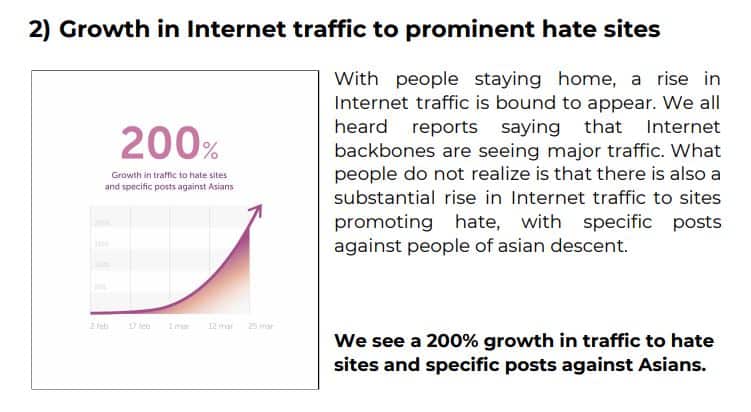
14. Hate speech among children and teens increased in early 2020
Since COVID-19 hit, children have been kept away from many of their regular activities and have been spending more time online, including using social media networks and messaging apps. L1ght reported that during the first round of COVID-19 lockdowns, there was a 70 percent increase in the number of instances of hate speech between teens and children. The study also found a 40% increase in the amount of toxicity found among gamers on Discord.
15. Two US states have little or no hate crime laws
While most states have hate crime laws that cover a wide range of biases, several states have no set laws against hate crimes. These are South Carolina and Wyoming. And for some states that do have bias crime laws, there is concern that they are not very effective. For example, Utah’s hate crime statute was referred to as worthless by the district attorney of Salt Lake County in 2018 while Arkansas’ fails to account for racial, gender, or sexuality-based discrimination.
16. Facebook acted on more than 17 million instances of hate speech in Q4 2021
As part of its transparency initiative, Facebook releases a Community Standards Enforcement Report each quarter. In October–December 2021, Facebook detected and took action on 17.4 million pieces of content containing hate speech. This was a decline from the previous quarter figure of 22.3 million, but still significantly higher than Q1 2020 when only 9.5 million instances were taken action against.
17. Facebook proactively detected 96.5% of hate speech
According to a 2021 Facebook update regarding hate speech detection, “AI now proactively detects more of the hate speech removed from Facebook”. This progress is reflected in the most recent Community Standards Enforcement Report which shows that, of the violating content that Facebook actioned for for hate speech, some 96.5% was found and flagged by Facebook before it was found and reported by users.
18. Over 1,000 advertisers boycotted Facebook over a hate speech row
In mid-2020, as part of the Stop Hate for Profit campaign, more than 1,000 companies, including Coca-Cola, Unilever, and North Face, stopped promoting on Facebook, putting a dent in the social media giant’s $70 billion advertising business. The boycott ended once Facebook, along with Twitter and YouTube agreed with advertisers on an acceptable definition of harmful content.
19. In Q2 2021, TikTok removed 1.78 million videos that violated its hate speech policy
TikTok, the increasingly popular short-form video-sharing app, has cracked down on hate speech. In its Q2 2021 Community Guidelines Enforcement Report, it stated that it had removed 81,518,334 videos between the months of April and June 2021. Of this number, 1.78 million (2.2 percent) werqe categorized as hateful behavior. 80.8 percent of these videos were removed within 24 hours of being posted, and 60.6 percent had zero views at the time of their removal.
20. 1.1 million Twitter accounts were actioned for hateful conduct violations from January to June 2021
Twitter regularly updates its hateful conduct policy, including expansions at least once per year over the past several years. It took action (in the form of removing tweets and banning accounts) on 1,108,722 accounts in the first half of 2021 for infringing on this policy on hateful conduct. According to a Twitter Transparency report, this was a 36% increase during this reporting period.
21. Northern Ireland recorded a sharp rise in racial hate crimes in Q1 2022
A May 2022 update from PSNI (PDF) shows that racially-motivated hate crimes were at their highest level since the 2014-2015 reporting period. The report stated the lowest levels of racial hate crime were typically in December and February, whereas the average highest level of reports was in September and October.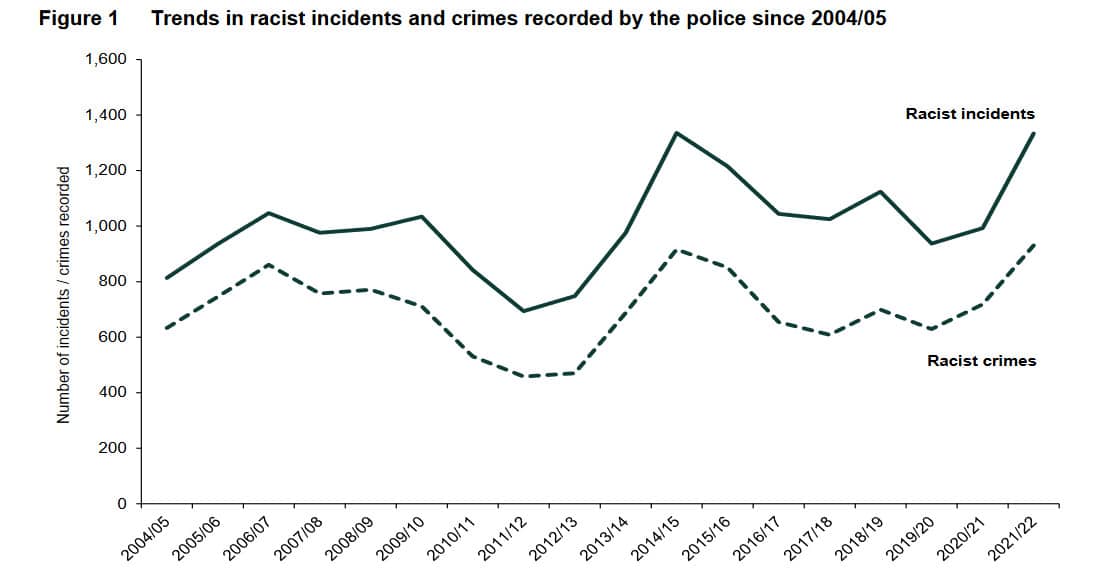
22. Homophobic incidents are at their highest levels since 2004
The PSNI report continued, showing that hate crimes had increased in the 2016/17 and 2019/20 reporting periods. Since then, the figures show a worrying rise in homophobic hate crimes for 2020/21
and 2021/22 reporting periods – now at their highest level since the reports began in 2004.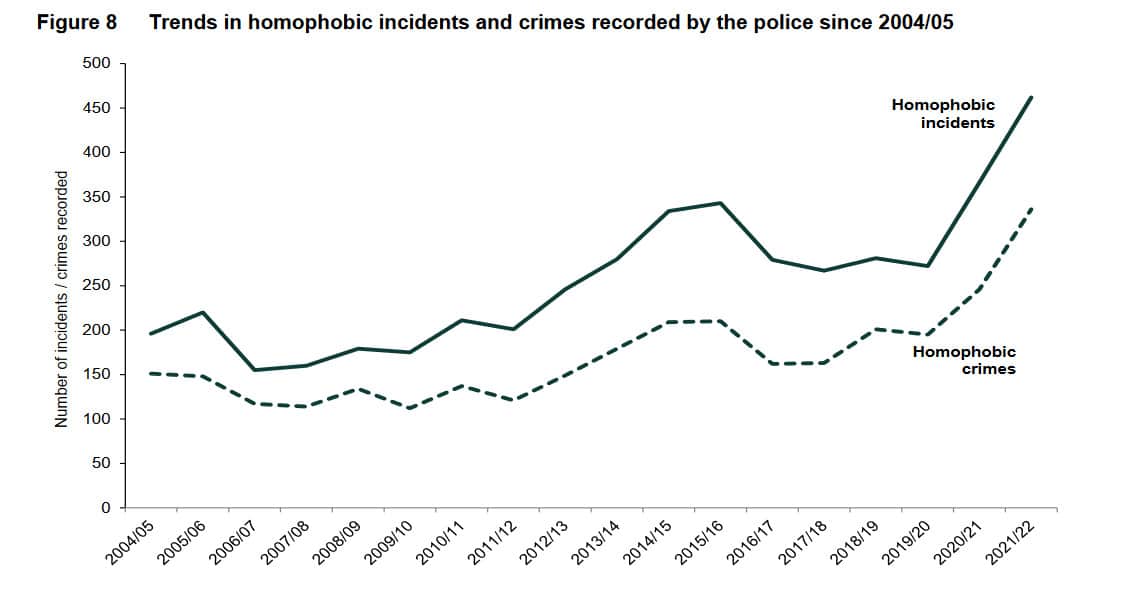
23. The most significant type of abuse in 2020 was from online insults
A 2020 study from Report-IT found that insults were the most common type of online hate incident, with 97% of respondents saying they’d experienced some form of insult. Threats of physical violence followed closely, with 63% of those surveyed saying they’d received such threats.
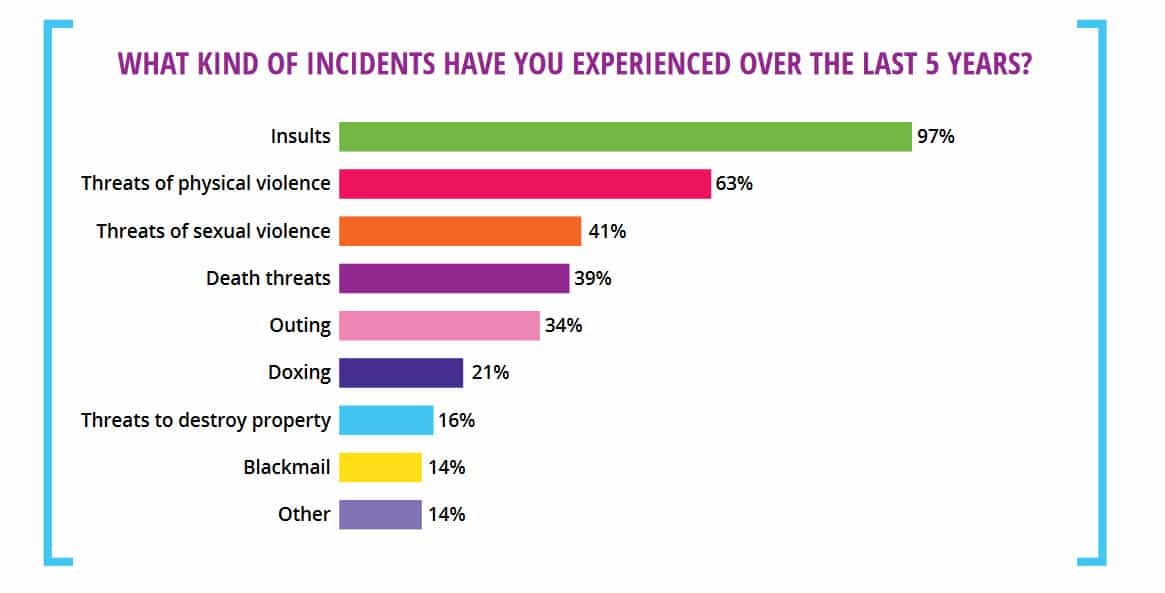
24. Attacks were mainly directed at individuals instead of groups of people
Report-It also showed that 68% of individuals were the main target of online hate attacks. The entire LGBT+/the LGBT+ community was the next most significant target for online abuse, according to 20% of respondents.
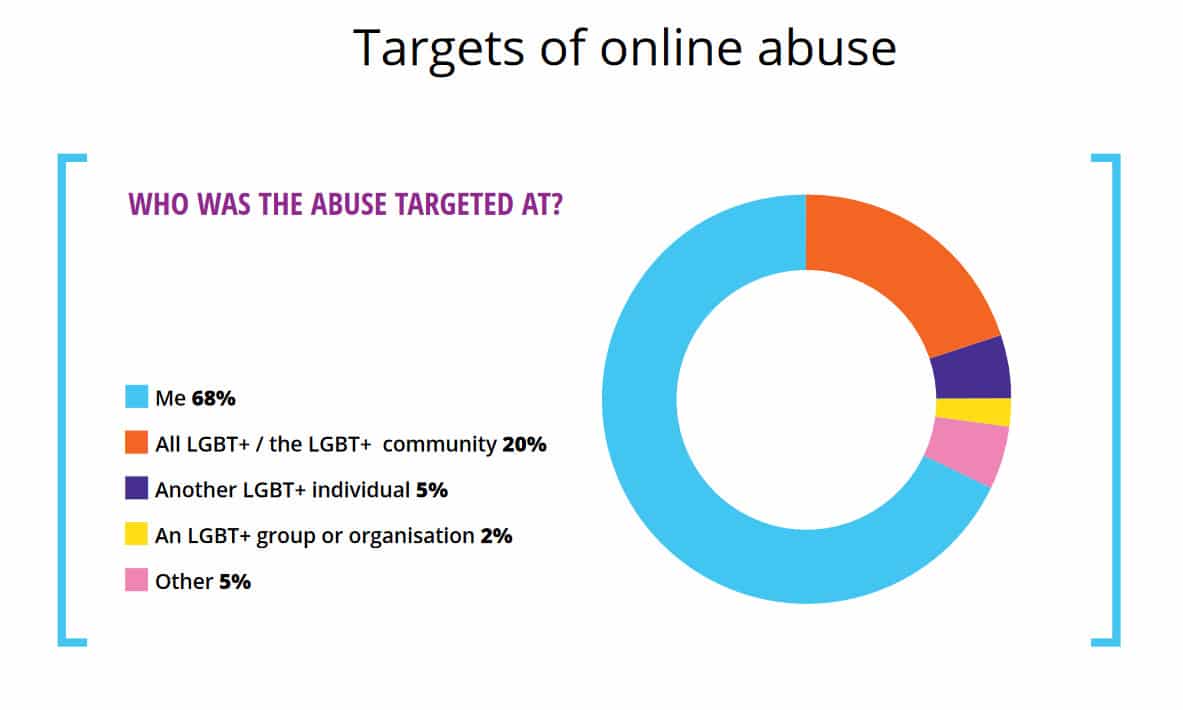
25. Facebook was the biggest platform for online abuse in 2020
The report continued, showing that 58% of online hate crimes reported targeted users on Facebook. Twitter was the next biggest platform for online abuse, with 34% of users reporting incidents.
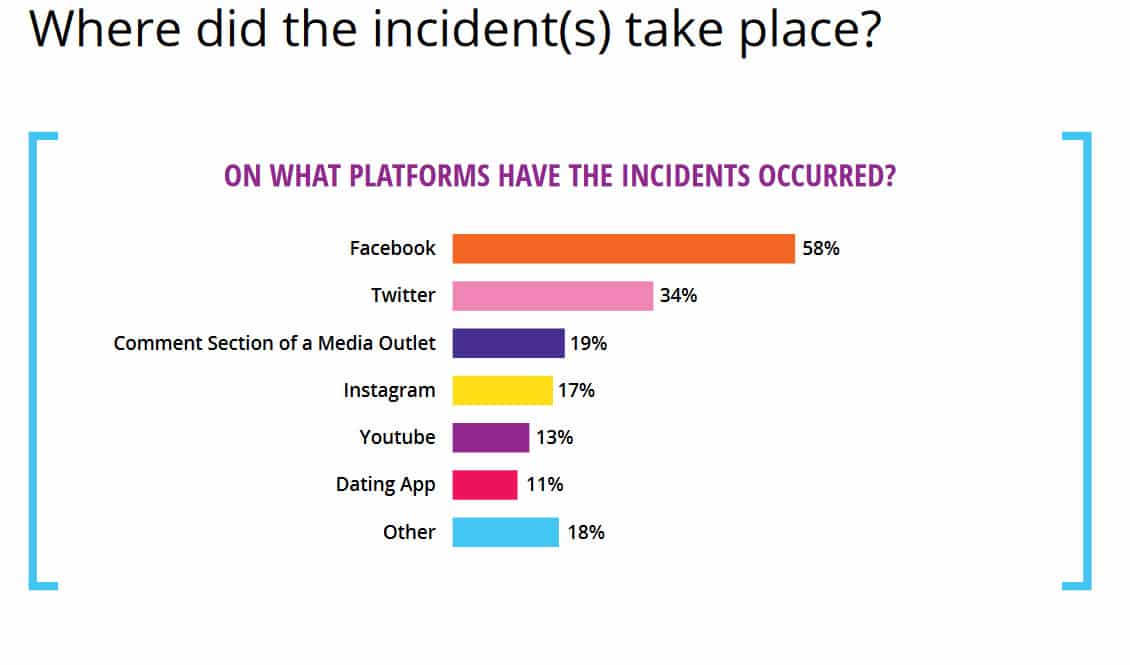
FAQs about hate crime
What is a hate crime?
A hate crime is defined as a criminal act against a person or property motivated by bias against a particular group. The term “hate crime” covers a wide range of offenses, including but not limited to, assault, battery, arson, vandalism, and murder.
The vast majority of hate crimes are committed by individuals who are not members of any organized hate group. However, there has been a recent increase in the number of hate groups in the United States, which has coincided with an increase in the number of hate crimes.
What motivates hate crime?
Hate crimes can be motivated by a variety of factors. In some cases, the offender may have personal grievances against the victim or group that they target. In other cases, the offender may simply harbor general hatred or bigotry towards the victim’s group. Still, others may commit hate crimes in an attempt to intimidate or coerce members of the victim’s group.
What is the punishment for hate crimes in the US?
In the United States, punishments for hate crimes vary by jurisdiction. They may include jail time, fines, community service, restitution to the victim (or their family), or a combination of these. Punishments may also involve civil suits against perpetrators. Penalties can be enhanced if it is determined that a person was targeted because of their race, religion, nationality, gender identity, sexual orientation, or disability. Some states have specific laws against hate crimes; others rely on existing criminal codes to prosecute them. In addition to individual punishment for perpetrators of hate crimes, some states and cities have passed resolutions condemning such actions and calling for more vigorous enforcement of existing laws. Additionally, organizations like the Anti-Defamation League work to combat hate and discrimination through education and training.
How can online hate crimes be prevented?
Preventing online hate crimes requires comprehensive efforts, including education and awareness, to understand and counteract such behaviors.
Enacting and enforcing laws against hate speech and related crimes provides a legal deterrent. Law enforcement needs sufficient resources for effective investigation and prosecution. Social media companies play a crucial role by monitoring and removing harmful content and educating users about recognizing and reporting hate speech and crimes.
Victims should document and report incidents and seek support from relevant organizations. Bystanders also contribute significantly by denouncing hate speech and supporting victims, fostering an inclusive and respectful online culture.
Can AI tools commit hate crimes?
AI-powered tools cannot commit hate crimes because they do not have feelings, thoughts, or intentions. Humans create and control these tools, and their actions are based on their programming. However, if these tools are trained on biased data or used maliciously, they can spread harmful stereotypes, harass individuals, and propagate hate speech. For example, an AI chatbot trained on hate speech data may generate offensive responses. It is important for humans to prevent this misuse by using unbiased training data, filtering harmful content, and monitoring the use of AI tools.


